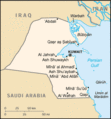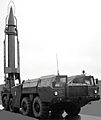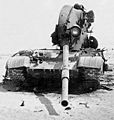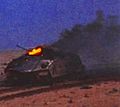Gulf War facts for kids
Quick facts for kids Persian Gulf War |
|||||||
|---|---|---|---|---|---|---|---|
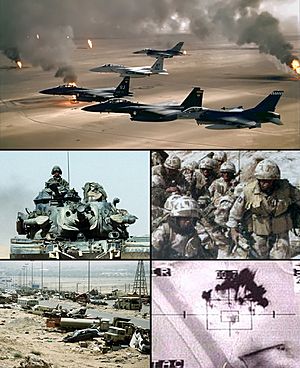 |
|||||||
|
|||||||
| Belligerents | |||||||
| Commanders and leaders | |||||||
| Strength | |||||||
| 956,600, including 700,000 US troops | 650,000 soldiers | ||||||
| Casualties and losses | |||||||
|
Coalition: |
Iraqi: 25,000–50,000 75,000+ wounded 80,000 captured 3,300 tanks destroyed 2,100 APCs destroyed 2,200 Artillery Pieces destroyed 110 Aircraft destroyed 137 Aircraft escaped to Iran 19 naval ships sunk, 6 damaged |
||||||
The Persian Gulf War, also known as the Gulf War, was a big conflict between Iraq and a group of 34 other countries. This group was led by the United States. The war began when Iraq invaded its small neighbor, Kuwait, on August 2, 1990. Iraq had claimed for a long time that Kuwait was actually part of its own land. The war ended the next spring when Iraq's armies were defeated.
Contents
Why Did the Gulf War Start?
Iraq had just finished a long war with Iran, called the Iran–Iraq War. This war ended in 1988. Iraq owed a lot of money to countries like Saudi Arabia and was finding it hard to pay them back.
The leader of Iraq at the time, Saddam Hussein, said that Kuwait was stealing Iraq's oil. He claimed Kuwait was taking oil from wells that stretched across their shared border. Because of these reasons, Iraq decided to invade Kuwait.
Two Main Operations: Desert Shield and Desert Storm
The war involved two main military operations.
Operation Desert Shield
This operation started right after Iraq invaded Kuwait. Its main goal was to send troops to protect Saudi Arabia and other nearby Gulf states. These countries were worried that Iraq might attack them next. The troops were there to defend these nations and stop Iraq from expanding its control.
Operation Desert Storm
This was the attacking part of the war. It began on January 17, 1991, with a huge air attack. Airplanes bombed Iraqi forces in Kuwait and inside Iraq itself. On February 24, ground troops also started fighting. As Iraqi forces retreated, they set fire to many oil wells in Kuwait. This was done to slow down the attacking forces.
New Technologies Used in the War
The attacks during Operation Desert Storm used some very advanced weapons for that time. These included:
- Stealth aircraft: These planes were designed to be very hard for enemy radar to detect.
- Cruise missiles: These were long-range missiles that could fly low to the ground and hit targets very accurately.
- Smart bombs: These bombs could be guided precisely to their targets, making them much more accurate than older bombs.
These new technologies helped the coalition forces a lot.
The End of the War
After 42 days of fighting, the President of the United States, George H. W. Bush, announced a ceasefire on February 28, 1991. By this time, most Iraqi soldiers in Kuwait had either given up or run away.
The bombing campaign during Operation Desert Storm hit many important Iraqi targets. These included Iraqi aircraft, systems that protected against air attacks, oil refineries, and weapon factories. Bridges and roads were also bombed to make it harder for Iraqi forces to move.
The war was a very clear victory for the coalition forces. Even though Iraq was defeated, President George Bush decided not to remove Saddam Hussein from power at that time.
After the War
Some political problems that came up after the first Gulf War eventually led to another conflict. This was the 2003 invasion of Iraq, which is sometimes called the second Persian Gulf War.
Related pages
Images for kids
-
Donald Rumsfeld, US special envoy to the Middle East, meets Saddam Hussein on 19–20 December 1983.
-
Kuwaiti Armed Forces Chieftain main battle tanks
-
Kuwait Air Force McDonnell Douglas A-4KU Skyhawk ground-attack aircraft
-
Kuwaiti Armed Forces M-84 main battle tanks
-
General Norman Schwarzkopf, Jr. and President George H. W. Bush visit US troops in Saudi Arabia on Thanksgiving Day, 1990.
-
Dick Cheney meets with Prince Sultan, Minister of Defence and Aviation in Saudi Arabia to discuss how to handle the invasion of Kuwait.
-
Gen. Colin Powell (left), Gen. Norman Schwarzkopf Jr., and Paul Wolfowitz (right) listen as Secretary of Defense Dick Cheney addresses reporters regarding the 1991 Gulf War.
-
The USAF F-117 Nighthawk, one of the key aircraft used in Operation Desert Storm
-
US M1A1 Abrams tanks from the 3rd Armored Division along the Line of Departure
-
The oil fires caused were a result of the scorched earth policy of Iraqi military forces retreating from Kuwait.
-
Remains of a downed F-16C
-
Argentine Navy Alouette III helicopter on board USNS Comfort, February 1991
-
British Army Challenger 1 main battle tank during Operation Desert Storm
-
USS Missouri launching a Tomahawk missile. The Gulf War was the last conflict in which battleships were deployed in a combat role.
See also
 In Spanish: Guerra del Golfo para niños
In Spanish: Guerra del Golfo para niños



